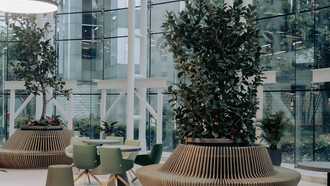The neighborhood we commonly call "Once" (which literally translates to “eleven”) because it is centered around Plaza Once de Septiembre, is actually Balvanera and is located just a few blocks from the National Congress. It is a historic district of the city and a bustling commercial hub. In this area, various communities coexist (Koreans, Chinese, Bolivians, Peruvians, Senegalese, Orthodox Jews, and more) alongside architectural heritage gems that reflect its more bourgeois past in the early decades of the last century. With his unique vision of art nouveau, one architect left an indelible mark on the neighborhood and the city.
Virginio Colombo was born in Milan in 1884, studied at the Brera Academy of Fine Arts, and was a disciple of Camillo Boito and Giuseppe Sommaruga. He arrived in Argentina in 1906, invited by the Ministry of Public Works to work on the decorative moldings of the Palace of Justice. According to Nicolás Fratarelli, an architect and researcher of his work, it is estimated that Colombo developed 50 buildings in the city. Colombo did not leave written records; his works speak for him and his clients. His architectural work was intrinsically linked to the Italian community he was part of, one of the most important and economically powerful due to its large numbers.
With the massive immigration to the country between the late 19th and early 20th centuries came people and ideas that transformed Argentine society. Thousands of these immigrants were professionals or artisans who found excellent raw materials to develop their crafts. For example, the shoe industry found magnificent leather, and its small entrepreneurs quickly grew economically. Thus, they began hiring architects like Colombo to build their houses, which needed to accommodate a workshop space and retail stores. Most of his works are of this type. His major works, such as Casa de los Pavos Reales (1912), Casa Grimoldi (1918), and Casa Anda (1922), were built for major shoe industry entrepreneurs of the time.
At the beginning of the 20th century, the country's upper classes continued to prefer French academicism for their mansions and major public works. However, the burgeoning bourgeoisie, composed of immigrants who quickly enriched themselves due to the country's economic dynamism during those decades, opted for other anti-academic trends like art nouveau. We can exemplify these two visions with two constructions from the same year that could not be more different: in 1919, the Errázuriz Alvear Palace (now the Museum of Decorative Art), designed by René Sergent, and Casa Calise, designed by Colombo, were built.
This was the era when the architect was also an artist and designer. The movements we analyze here proposed new articulations between art and craftsmanship (a later example would be the Bauhaus). Colombo was involved in every detail of his creations, from the hardware to the furniture and vitraux. But it is in the façades where he unfolds his particular vision of Italian art nouveau (also known as Liberty), drawing on what he learned from his mentors Boito and Sommaruga. Thus, we see cherubs, nymphs, lions, and, of course, Dante Alighieri, since his predecessors advocated a return to the classical Lombard religious aesthetics and the architecture of Venice and Milan.
From my perspective, we can make a sociological reading and think that Colombo's clients chose this aesthetic proposal to demonstrate their wealth and purchasing power, knowing they could not compete with the elite's houses. Perhaps, from the perspective of these people, who today we would undoubtedly call nouveau riche, this explosion and drama of art nouveau was "beautiful" and "in good taste." We know counterfactual history is not right, but since I'm not a historian, I allow myself this license. We can also think that this aesthetic choice for their homes and businesses linked migrants to their motherland, Italy. Although, interestingly, the art nouveau vision Colombo proposed was linked to the aesthetics of northern Italy, the economically wealthiest sector.
Colombo died in Buenos Aires in 1927, but in the 21 years he spent in the city, he changed its image forever. The works of Colombo that remain, though unfortunately few and in various states of conservation, are undoubtedly works of art that leave anyone who takes the time to stop on the street and look at the façades breathless.
Currently, Colombo is present in the city's news for two reasons. The first one, the good news, is that at the end of 2024, the restoration of Casa Anda in the Congreso neighborhood began. It had been in a state of total abandonment for several decades and was even believed to be haunted. The restoration of one of his most ambitious works, Società Unione Operai Italiani, is also expected. According to some sources, it would be the future Argentine headquarters of the Church of Scientology.
But the second one, the bad news, is that one of his works, restored in 2022 by the neighbors' initiative, Casa Viacava from 1917 in the Almagro neighborhood, is at risk of collapse due to a neighboring construction that does not comply with the regulations for its execution. One of the apartments became completely uninhabitable, and the owner's plea for justice on social media, Arturo Blas, went viral. Blas was left on the street with his cat without any response from the state or the construction company that destroyed his property.
Buenos Aires is losing its identity. Faced with the advance of the real estate business, which launders money with low-quality and aesthetically ugly works, Colombo's legacy is even more precious.














